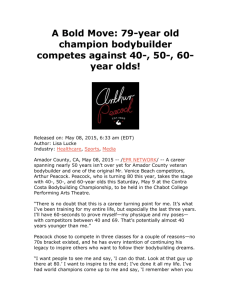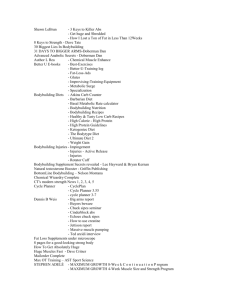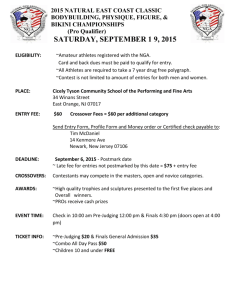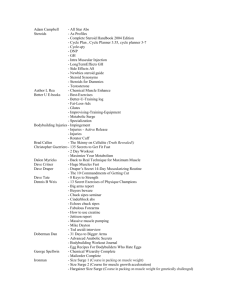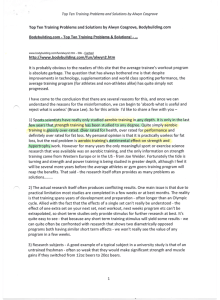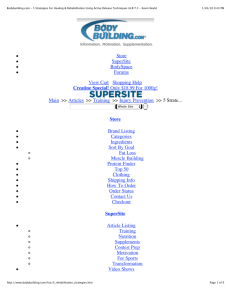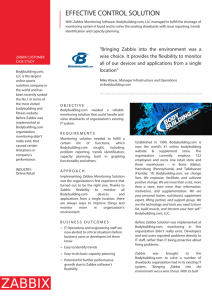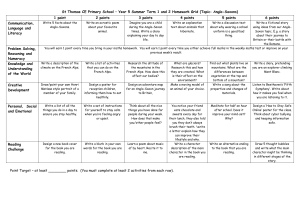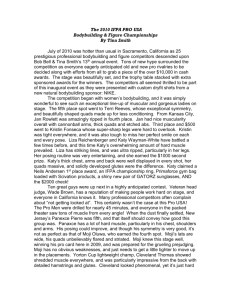`Healthy` spaces for recreation - Institute of Historical Research
advertisement
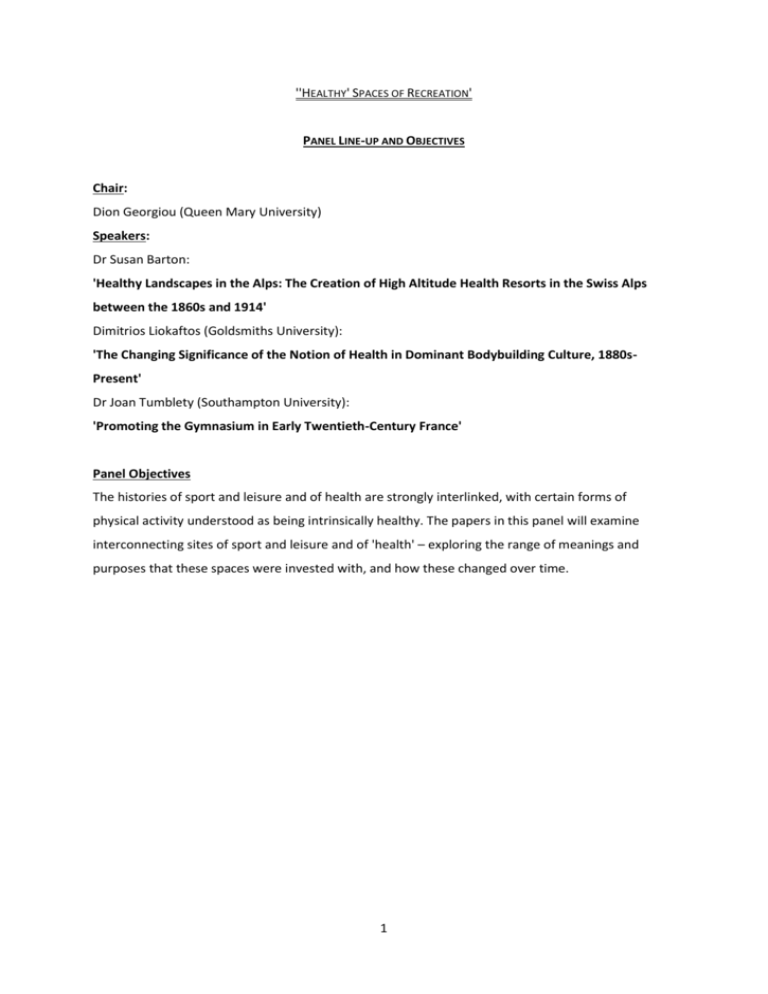
''HEALTHY' SPACES OF RECREATION' PANEL LINE-UP AND OBJECTIVES Chair: Dion Georgiou (Queen Mary University) Speakers: Dr Susan Barton: 'Healthy Landscapes in the Alps: The Creation of High Altitude Health Resorts in the Swiss Alps between the 1860s and 1914' Dimitrios Liokaftos (Goldsmiths University): 'The Changing Significance of the Notion of Health in Dominant Bodybuilding Culture, 1880sPresent' Dr Joan Tumblety (Southampton University): 'Promoting the Gymnasium in Early Twentieth-Century France' Panel Objectives The histories of sport and leisure and of health are strongly interlinked, with certain forms of physical activity understood as being intrinsically healthy. The papers in this panel will examine interconnecting sites of sport and leisure and of 'health' – exploring the range of meanings and purposes that these spaces were invested with, and how these changed over time. 1 ABSTRACTS Dr Susan Barton: 'Healthy Landscapes in the Alps: The Creation of High Altitude Health Resorts in the Swiss Alps between the 1860s and 1914' Encouraged by positive reports from medical practitioners and in the absence of effective therapeutics, from the mid-1860s sufferers with respiratory diseases and tuberculosis made for high alpine villages, primarily Davos, St Moritz, Arosa and Leysin in the hope of a cure. The alpine landscape around these villages was transformed into a space of promoting health and healing. New kinds of accommodation, luxury hotels followed by sanatoria, soon covered the slopes around these villages, transforming them into small towns in less than a generation. Sanatoria were positioned on south facing slopes so that patients could lie facing the sun in the open air for several hours a day as part of a strict Cure regime of nutrition, rest and exercise. During stays of months or even years, patients or guests needed amusements to alleviate the boredom and to enliven their exercise periods. They turned the slopes around the villages into sledge runs and created ice rinks on flat land. These guests were often accompanied by healthy family members and friends who also needed amusement, especially during the patients’ rest periods. Soon more people, mostly British at this time, were coming out to the Alps where the sick and sound heartily joined in together in these novel winter pastimes that soon evolved into organised sports with clubs, competition, rules and eventually codification. This take-over by the British led to their dominance in winter sports during the late Victorian and Edwardian period and the transformation of some resorts into English colonies dedicated to health and recreation. Soon they were joined by the wealthy of other nationalities. The landscape itself was imbued with qualities conducive to maintaining health and promoting healing. The high altitude, with its pure and thinner air, promoted fitness and killed disease carrying microbes, claimed promotional literature. An increase in red oxygen-rich blood cells, helped bodies weakened in the industrial environments of the lowlands, become strong and resistant to disease. The cold, inhospitable, snowy mountain landscape had become an international space where the celebration of good health by those who annually dedicated the entire winter season to physical activities juxtaposed the search for health by patients with diseased bodies. Dimitrios Liokaftos (Goldsmiths University): 'The Changing Significance of the Notion of Health in Dominant Bodybuilding Culture, 1880sPresent' 2 Adopting a socio-historical approach, this paper attempts to trace the changing significance of health in dominant bodybuilding culture from its inception (1880s) to the present. The developments discussed are situated in light of the culture’s ‘internal’ trajectory as well as its relation to wider national and global cultures. More specifically, I explore organised bodybuilding exhibitions as central in their capacity as a) a representational space for producing notions of the ‘good’ body and, simultaneously, b) an entrepreneurial space where recreation becomes a business. Based on a variety of data, such as articles on the embodied practice featured in the specialised media, contest judging criteria and publicity materials, and interviews with important figures in today’s bodybuilding industry, the presentation will be structured around critical events in the culture’s historical course. This will be broadly divided in the following periods: a) The early period (1880s-1930s): In its cultivation of healthy, uniform and wholesome development, bodybuilding as recreation and formal display is promoted in light of the culturally legitimate discourses of science, bodily awareness, aesthetic rationalization, and expert knowledge. Simultaneously, advocates of bodybuilding employ the widespread fin de siècle discourse of degeneration to frame their systems of rational recreation as crucial for a healthy and militarily powerful Nation. b) The middle period (1940s-1970s): Muscular development is still considered a derivative of fundamental physical qualities such as health and strength. Introduced in the universe of organised athletics, bodybuilding is framed as healthy and regenerative not only in terms of the physical but of the moral constitution of the individual as well. In this sense, it is promoted as beneficial for a fit and upright masculinity and citizenship. c) The later period (1980s-present): Although initially incorporated in the larger ‘fitness’ movement, dominant bodybuilding culture progressively turns insular. Divorced from the holistic triptych of ‘health, strength and beauty’ that had traditionally served as the dominant definition of bodybuilding, muscular development becomes fetishised; in today’s dominant bodybuilding culture, self-defined as an ‘extreme sport,’ the quest for development becomes problematic as risky practices (including -but not limited to- drug use) are increasingly normalised. In ‘following’ the development of the nuclei of dominant, organised bodybuilding culture, the discussion on the early period (1880s-1930s) examines both the British and American context, while the discussion on the middle and later periods (1940s-1970s/1980s-present) ‘naturally’ comes to focus on the American context in its capacity as a national paradigm of profound global influence. 3 Dr Joan Tumblety (Southampton University): 'Promoting the Gymnasium in Early Twentieth-Century France' This paper explores the ways in which the gymnasium, physical culture school and sports stadium became key sites – both real and discursive – for the making of ‘healthy’ bodies in the first half of the twentieth century in urban France. Collectively they represent the spaces in which the sports and gymnastics movement was manifested after the remarkable late nineteenth-century explosion in the mass practice of physical exercise and competition. Yet the range of ‘experts’ who invested interest in this development – physicians, politicians and journalists among others – were just as likely to express concerns about the potential of the activities performed in these places to undo the health of the male and female bodies that moved within them. Indeed, many voices converged in a widespread critique of the ‘spectacle’ of sport in which participants were bound by the greedy laws of the market and onlookers condemned to unhealthy corporeal passivity. But many scientists and medics also criticised the performance of sporting activity itself for its alleged ‘specialisation’ which prevented the ‘harmonious development’ of the human machine. In this debate, those physician entrepreneurs who dominated the world of body building and get-fit literature (James-Edward Ruffier, Edmond Desbonnet, Henri Diffre, among others) posed the gymnasium as a healthy alternative to the stadium, for the opportunities it afforded for a ‘rational’ working out of the muscles. A study of these commentators reveals how far-reaching was the role played by physicians in the popular culture of the period, and how that popular culture had become saturated with medicalised notions of both physical and moral health. Indeed, underpinning their concerns lay assumptions and convictions about systems of sex-difference, the promise of eugenics to solve social problems and the ability of physical exercise to address what is often described as the ‘critique of civilisation’. BIOGRAPHIES Dion Georgiou: Dion Georgiou is a founding member and convenor of the IHR Sport and Leisure History Seminar. Dion is currently undertaking doctoral research at Queen Mary University into local charity festivals in Greater London between 1900 and 1939, which includes examination of fundraising initiatives on behalf of and community relationships with local hospitals. Dr Susan Barton: 4 Susan Barton is the author of Healthy Living in the Alps: The Development of Winter Tourism in Switzerland, 1860-1914 and also Working-Class Organisations and the Development of Popular Tourism, both published by Manchester University Press. Other works include A Sporting Chance: The History of Special Olympics GB and Twisted Yarns: The History of the Hosiery Industry in Hinckley, as well as many papers, articles and media contributions. Current research interests are in the cultural history of tourism, the history of sliding sports, and sporting and social inclusion for people with learning disabilities. Dr Barton has recently completed a project investigating the legacy and impacts of the Special Olympics National Summer Games in Leicester as a Research Fellow shared between the University of Leicester and De Montfort University. Dimitrios Liokaftos: Originally from Sparta, Greece, Dimitrios Liokaftos completed his BA in English and Greek Literature, Language, and Culture (University of Athens) and MA in Gender, Society and Culture (Birkbeck College, University of London) before embarking on his PhD research (Department of Sociology, Goldsmiths, University of London). His thesis explores the development of the notion of ‘monstrosity’ in dominant bodybuilding culture from its very beginnings (1880s) to the present. On the early period of bodybuilding and physical culture, Dimitrios has published “Imaging the Reformed Man”, in Antonis Balasopoulos, Gesa Mackenthun and Theodora Tsimpouki (eds.), Conformism, Non-Conformism and Anti-Conformism in the Culture of the United States (2008). Dr Joan Tumblety: Joan Tumblety teaches history at the University of Southampton and specialises in the cultural and gender history of early twentieth-century France. She is currently completing a book project entitled Remaking the Male Body: Masculinity and the Uses of Physical Culture in Inter-War France, which seeks to bring together a discussion of the sports movement, normative masculinity and ideas about biological degeneration. Since 2006 she has been an editor of the interdisciplinary journal Modern & Contemporary France. 5
